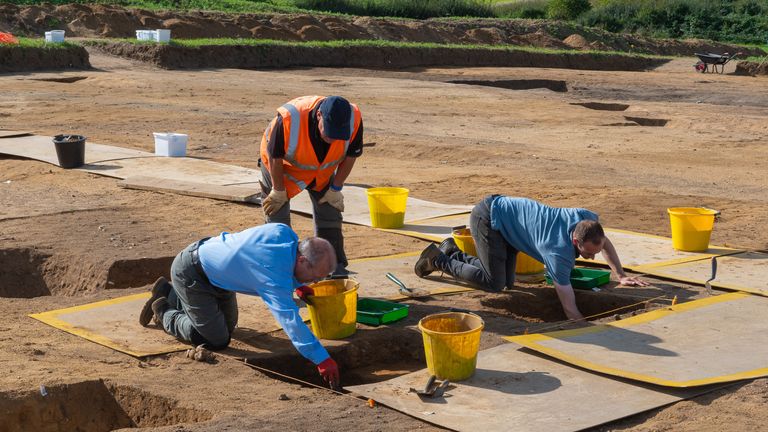The remains of a “possible temple” from 1,400 years ago showing the “power and wealth” of the East Anglian kings have been discovered on farmland near Sutton Hoo in Suffolk.
Excavations in the summer at Rendlesham revealed the foundations of three timber buildings, including the possible temple – and identified evidence of 7th century metal working.
Two graves of an unknown date, and evidence of earlier settlement and activity from the Neolithic, Bronze Age, Iron Age and Roman periods, were also uncovered.
Nearby Sutton Hoo was the site of one of the greatest ever British archaeological finds in 1939 – the remains of an Anglo-Saxon ship grave containing dazzling gold and jewelled treasure.
Suffolk County Council said the latest find comes after the remains of a large timber royal hall were uncovered at Rendlesham, near Woodbridge, last year, which confirmed the spot as a settlement of the East Anglian kings.
This year’s digs found evidence of fine metalworking associated with royal occupation, including a mould used for casting decorative horse harnesses similar to those found at Sutton Hoo, the council said.
Sutton Hoo is thought to be the final resting place of King Raedwald, who ruled in the seventh century.
The site at Rendlesham was described as an East Anglian royal centre by monk and historian The Venerable Bede in his Ecclesiastical History Of The English People, written in 731CE (AD).
The compound at Rendlesham was found to be the size of around 20 football pitches.
The royal residence was part of a wider complex covering 50 hectares which is unique in the archaeology of fifth to eighth century England in its scale and complexity, the council added.
The discoveries were made by the council’s Rendlesham Revealed lottery-funded community archaeology project.
The project’s principal academic adviser, Professor Christopher Scull, of Cardiff University and University College London, said: “The results of excavations at Rendlesham speak vividly of the power and wealth of the East Anglian kings and the sophistication of the society they ruled.
“The possible temple, or cult house, provides rare and remarkable evidence for the practice at a royal site of the pre-Christian beliefs that underpinned early English society.”
Prof Scull added: “Its distinctive and substantial foundations indicate that one of the buildings, 10 metres long and five metres wide, was unusually high and robustly built for its size, so perhaps it was constructed for a special purpose.
“It is most similar to buildings elsewhere in England that are seen as temples or cult houses, therefore it may have been used for pre-Christian worship by the early kings of the East Angles.”
The council said the excavations are complete and trenches at the site have been filled.
Provisional results from analysis of the findings are expected next year.
